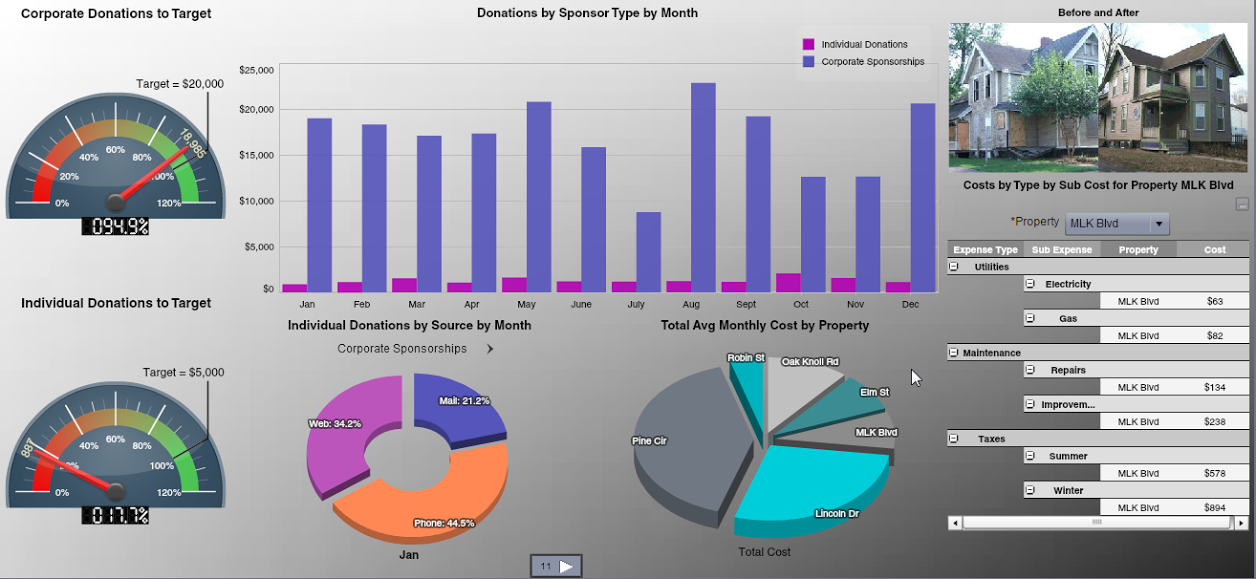Special to the Philanthropy Journal
By Nate DeGrande
How nonprofits can leverage dashboards to make better business decisions
Many nonprofit decision makers are embracing a powerful technology solution: dashboards. In the nonprofit sector, operating with unpredictable funding, managing large databases, and maximizing the value of donations comes with the territory. Compounding these challenges is the fact that many organizations rely on outdated or cumbersome reporting systems that make it difficult to draw meaningful conclusions from the data.
Dashboards integrate massive amounts of data from different sources into a single-screen presentation that can be understood at a glance. This visual tool combines unmatched clarity with analytical horsepower. High-quality dashboards provide an intuitive and accessible look at key metrics that organizations rely on in real-time. The result? Saved time, money, and the ability to make better  business decisions.
business decisions.
The dashboard difference
On a practical level, dashboard solutions capable of bringing together disparate data sources can transform data from databases or spreadsheets into a single, easy-to-understand report. Superior data visualization means that dashboard reporting provides not only context, but also clarity. For nonprofits, decision makers or a board of directors not only receive reports that are easy to understand and digest, but also help show trends that lead to more informed decisions.
The best dashboards are fully customizable and designed to display data ranging from specific organizational goals to revenue and key performance indicators (KPIs). Metrics related to short-term and long-term goals can also be monitored. In addition, nonprofits can use dashboards to track progress within individual programs or departments, or provide details about critical metrics (like fundraising levels during a specified timeframe).
Transparency is at the core of the nonprofit mission. Dashboards make it possible to provide that transparency by showing precisely where money is coming from and where it is going, and because dashboards are accessible in real-time, nonprofits can easily identify and address potential problems long before they become an issue.
Dashboard best practices
For the most successful launch of a dashboard solution, it is important to have a basic understanding of best practices for dashboard design and implementation:
Be strategic
Designing an effective dashboard begins with assessing where and how it can have the biggest impact on your organization and mission. One strategy is to rollout the first dashboards to upgrade reporting to the executives or the board of directors. Once the transformative impact of the system is clear, it can then be deployed across the organization.
Prioritize data
Don’t go into the process blind. Instead, think carefully and critically about what data is important, and how it can be presented in the most efficient way possible. Dashboards are powerful tools, but they are only as effective as the information that goes into them. When deciding on which data to focus, prioritize KPIs that provide the clearest picture of your operation.
Emphasize engagement
Appropriate rollout and training are essential. Fortunately, the best dashboard solutions are exceptionally user-friendly. Still, it is always a good idea to work with a dashboard provider that offers comprehensive training, support and ongoing maintenance.
Determine access
Structuring access and usage details are an important piece of the dashboard puzzle. It is important to think through who will be using the system and what information they will need to access. High-level executive decision makers will likely need to look at very different information than someone in fundraising or operations.
Dashboards do much more than just present information—they identify connections, correlations and hidden relationships that can lead to new insights and big ideas. They make it possible to optimize resource allocation, improve decision-making and enhance efficiencies. Those new efficiencies save an enormous amount of time and energy. These resource allocation insights allow nonprofits to operate in a lean and cost-effective manner. On the operational side, this means doing more with less. On the donor side, the result is maximizing the value and impact of donations.
In the nonprofit world, that’s a potential game-changer.
Nate DeGrande is a non-profit account representative with iDashboards, a Troy, MI-based provider of data visualization solutions. For more information, visit www.idashboards.com






